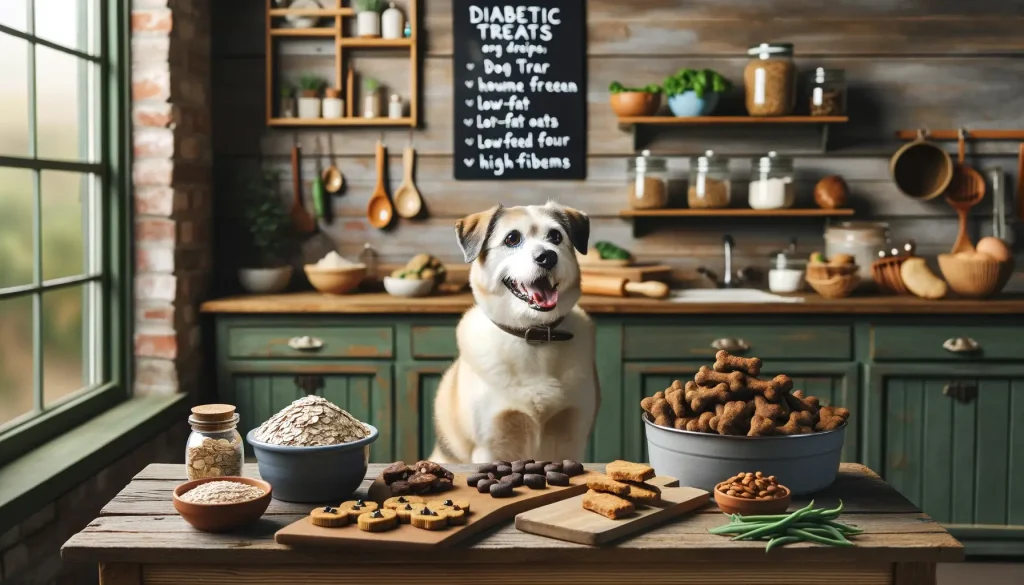
Best Diabetic Dog Treats for Your Friend
Finding the right treats for your diabetic dog can feel like navigating a minefield. With a rise in canine diabetes, understanding how to balance enjoyment with nutritional safety has become crucial for pet owners. Drawing insights from various sources, including Michelle’s contributions for PetTest as an AAHA Certified Diabetes Educator and the DogDeli Blog’s focus on natural and health-centric treat options, it’s clear that the well-being of diabetic dogs lies in selecting the right treats. Whether through homemade delights or carefully chosen commercial options, ensuring these treats align with your pet’s health requirements is key. Diabetic dogs need treats that support their dietary needs without spiking their blood sugar. From air-dried natural dog treats to clean eating principles, the emphasis is always on providing safe, nutritious options. But what exactly makes a treat safe for a diabetic dog, and how can you incorporate these treats into your dog’s diet without compromising their health?
Treat Options for Diabetic Dogs
Beyond nutrition, another layer that demands attention is the ingredients list. Knowing what is safe and what could potentially harm your diabetic pet is crucial. For instance, the emphasis on air-dried natural dog treats points to a growing concern over heavily processed options, with a shift towards more natural, minimally processed treats that retain more nutritional value without the added sugars or fillers that could exacerbate diabetes symptoms.
Moreover, the concept of clean eating for dogs is gaining traction, with a focus on simple, wholesome ingredients that contribute to a dog’s overall health without spiking blood glucose. This approach ties into the recommendations for homemade treats, offering pet owners a way to control exactly what goes into their dog’s diet, tailoring each treat to their dog’s specific needs.
The array of options ranges from baked goods to frozen delights, providing variety while sticking to guidelines that ensure these treats contribute positively to the management of diabetes in dogs. Specialists and dog nutrition blogs alike stress the importance of treats that are low in fat and devoid of simple sugars, yet rich in fiber to help regulate blood sugar levels.
Whether opting for commercially available treats or going the homemade route, the focus remains on allowing your pet to enjoy a treat without compromising their health. This balance is vital for diabetic dogs, whose well-being hinges on a carefully managed diet aligned with their unique dietary needs.

Diabetic Dog Treat Recipes
Creating homemade treats for your diabetic dog at home is both rewarding and simple. By focusing on safe ingredients and appropriate recipes, you can ensure your furry friend enjoys delicious treats without any risk to their health. Here, we’ll dive into how to make both baked and frozen treats that are perfect for diabetic dogs, using guidance from trusted sources.
Baked Treats for Diabetic Dogs
Baked treats are a fantastic way to control what goes into your dog’s diet. Here’s a quick recipe to get you started:
- Preheat your oven to 350°F.
- Mix together 2 cups of whole wheat flour, 1/2 cup of rolled oats, and 1 tablespoon of ground flaxseed in a bowl.
- Add in 1/2 cup of unsweetened apple sauce and 1/4 cup of water. Mix until a dough forms.
- Roll out the dough and cut into shapes with a cookie cutter.
- Bake for 30 minutes or until crispy.
These treats are not only easy to make but also ensure a high-fiber, low-fat snack suitable for diabetic pets.
Frozen Delights for Diabetic Dogs
Frozen treats are especially popular in the warmer months, offering a refreshing snack. Here’s an easy and safe recipe involves:
- Blending a cup of low-fat plain yogurt with half a banana.
- Pouring the mixture into ice cube trays or molds.
- Freezing until solid.
This simple recipe provides a low-sugar, enjoyable treat for dogs, using banana for a touch of natural sweetness and yogurt for a creamy texture.
Key Considerations for Homemade Treats
When making treats at home, it’s essential to focus on a few key factors:
- Always choose diabetic-friendly ingredients that are low in sugar and fat.
- Consult your vet to ensure the treats fit within your dog’s dietary plan.
- Remember, treats should only make up a small portion of your pet’s diet.
With these recipes and considerations in mind, you can easily prepare healthy treats for your diabetic dog at home, ensuring they enjoy every bite without compromising their health.

Selecting Ingredients for Diabetic Dog Treats
When crafting homemade diabetic dog treats, selecting the right ingredients is vital. Your choice of ingredients directly impacts your dog’s blood sugar levels and overall health. Let’s dive into how to pick safe and beneficial ingredients that will keep your furry friend happy and healthy.
Protein sources are essential for diabetic dogs. Opt for lean meats like chicken, turkey, or beef. These provide high-quality protein without unnecessary fats that could complicate your dog’s condition. Always ensure the meat is cooked and free from any seasoning or sauces.
For fiber, turn to vegetables such as green beans, carrots, and squash. Fiber aids in blood sugar regulation, making these veggies perfect for diabetic dogs. However, it’s crucial to cook them to aid in digestion. Raw vegetables can be hard for dogs to break down.
Grains can be a controversial topic in dog nutrition. Yet, certain whole grains like barley or oats are beneficial for diabetic dogs due to their low glycemic index. They provide energy without causing a rapid spike in blood sugar. Always cook grains thoroughly to make them easier for your dog to digest.
When considering fats, it’s all about balance. While diabetic dogs require some fat in their diets for energy, too much can lead to weight gain. Opt for healthy fats found in ingredients like flaxseed or fish oil. These can support your dog’s coat and skin health without overloading their diet with fats.
A common mistake is using sweeteners to enhance the taste of homemade treats. For diabetic dogs, avoid any added sugar or artificial sweeteners. If you want to add a hint of sweetness to a treat, natural options like pureed pumpkin or unsweetened apple sauce can provide flavor without the risk of spiking your dog’s blood sugar.
Remember, always consult with your vet before introducing new ingredients into your dog’s diet, especially when managing a condition like diabetes. Your vet can provide guidance tailored to your pet’s specific needs and help you craft a balanced and nutritious treat plan.


When to Visit the Vet with a Diabetic Dog
Keeping your diabetic dog healthy involves regular check-ups and knowing when a vet visit is necessary. Managing diabetes in dogs is a careful balance, and understanding when professional advice is needed can make all the difference. Here’s a look at when to seek veterinary guidance for your diabetic canine companion.
Firstly, any sudden change in your dog’s behavior, appetite, or energy levels warrants a vet visit. Diabetic dogs may experience fluctuations in blood sugar that can significantly impact their overall well-being. If your dog seems unusually lethargic, is drinking more water than usual, or has a sudden change in appetite, these could be signs that their diabetes is not well-controlled.
Additionally, regular check-ups are critical for monitoring your dog’s diabetes. These appointments allow your vet to track your dog’s blood sugar levels and make necessary adjustments to their insulin dosage or diet. Ideally, diabetic dogs should see their vet every 3 to 6 months for a comprehensive evaluation, but your vet may recommend more frequent visits based on your dog’s particular needs.
Monitoring your diabetic dog’s weigh is also essential. Weight loss or gain can indicate that your dog’s diabetes is not well-managed. If you notice any significant changes in your dog’s weight, it’s time to check in with your vet. Weight management is a key component of diabetes care, and your vet can provide guidance on diet and exercise to keep your dog at a healthy weight.
Lastly, be vigilant for signs of diabetes-related complications, such as cataracts, which can lead to blindness in dogs, or infections. Diabetic dogs are more susceptible to health issues, and early detection and treatment by your vet can prevent more serious problems.
Beginner Guide to Raising Quail at Home
What are the Signs of a Dog Concussion?
What Causes Your Dog’s Ears to Smell Bad?
When your dog’s ears start to emit an unpleasant odor, it might leave you puzzled…
Methimazole Treatment for Cat Hyperthyroidism
Methimazole plays a crucial role in managing feline hyperthyroidism, a condition marked by an overactive…
Got Hummingbirds in your Backyard? Here’s How to Care for Them.
Why Does Your Cat Pee Outside the Litter Box?
Cat’s Litter Box Issues It’s not uncommon for cat owners to face the frustrating dilemma…




